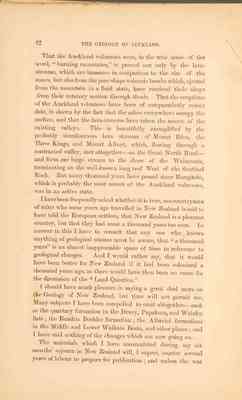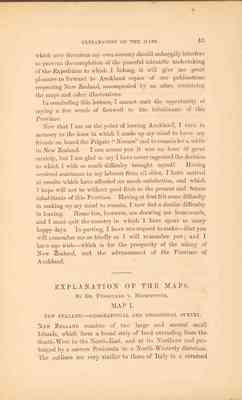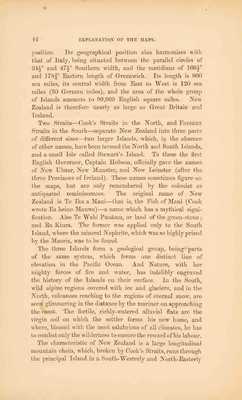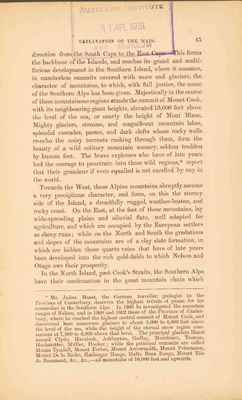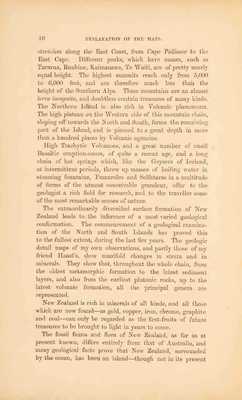Pages
42 THE GEOLOGY OF AUCKLAND.
That the Auckland volcanoes were, in the true sense of the word, "burning mountains," is proved not only by the lavastreams, which are immense in comparison to the size of the cones, but also from the pear-shape volcanic bombs which, ejected from the mountain in a fluid state, have received their shape from their rotatory motion through the air. That the eruptions of the Auckland volcanoes have been of comparatively recent date, is shown by the fact that the ashes everywhere occupy the surface, and that the lava-streams have taken the course of the existing valleys. This is beautifully exemplified by the probably simultaneous lava streams of Mount Eden, the Three Kings, and Mount Albert, which, flowing through a contracted valley, met altogether - on the Great North Road - and form one large stream to the shore of the Waitemata, terminating on the well-known long reef West of the Sentinel Rock. But many thousand years have passed since Rangitoto, which is probably the most recent of the Auckland volcanoes, was in an active state.
I have been frequently asked whether it is true, as a countryman of mine who some years ago travelled in New Zealand is said to have told the European settlers, that New Zealand is a pleasant country, but that they had come a thousand years too soon. In answer to this I have to remark that any one who knows anything of geological science must be aware, that "a thousand years" is an almost inappreciable space of time in reference to geological changes. And I would rather say, that it would have been better for New Zealand if it had been colonized a thousand years ago, as there would have then been no case for the discussion of the "Land Question."
I should have much pleasure in saying a great deal more on the Geology of New Zealand, but time will not permit me. Many subjects I have been compelled to omit altogether - such as the quartary formation in the Drury, Papakura, and Waiuku flats; the Basaltic Boulder formation; the the Alluvial formations in the Middle and Lower Waikato Basin, and other places; and I have said nothing of the changes which are now going on.
The materials which I have accumulated during my six months' sojourn in New Zealand will, I expect, require several years of labour to prepare for publication; and unless the war
EXPLANATION OF THE MAPS. 43
which now threatens my own country should unhappily interfere to prevent the completion of the peaceful scientific undertaking of the Expedition to which I belong, it will give me great pleasure to forward to Auckland copies of our publications respecting New Zealand, accompanied by an atlas, containing the maps and other illustrations.
In concluding this lecture, I cannot omit the opportunity of saying a few words of farewell to the inhabitants of this Province.
Now that I am on the point of leaving Auckland, I turn in memory to the hour in which I made up my mind to leave my friends on board the Frigate "Novara" and to remain for a while in New Zealand. I can assure you it was an hour of great anxiety, but I am glad to say I have never regretted the decision to which I with so much difficulty brought myself. Having received assistance in my labours from all sides, I have arrived at results which have afforded me much satisfaction, and which I hope will not be without good fruit to the present and future inhabitants of this Province. Having at first felt some difficulty in making up my mind to remain, I now feel a similar difficulty in leaving. Home ties, however, are drawing me homewards, and I must quit the country in which I have spent so many happy days. In parting, I have one request to make - that you will remember me as kindly as I will remember you; and I have one wish - which is for the prosperity of the colony of New Zealand, and the advancement of the Province of Auckland. ____________________
EXPLANATION OF THE MAPS. By Dr. Ferdinand v. Hochstetter.
MAP I.
NEW ZEALAND. - GEOGRAPHICAL AND GEOLOGICAL SURVEY.
New Zealand consists of two large and several small Islands, which form a broad strip of land extending from the South-West to the North-East, and at its Northern end prolonged by a narrow Peninsula in a North-Westerly direction. The outlines are very similar to those of Italy in a reversed
44 EXPLANATION OF THE MAPS.
position. Its geographical position also harmonises with that of Italy, being situated between the parallel circles of 34½⁰ and 47½⁰ Southern width, and the meridians of 166½⁰ and 178¾⁰ Eastern length of Greenwich. Its length is 800 sea miles, its central width from East to West is 120 sea miles (30 German miles), and the area of the whole group of Islands amounts to 99,969 English square miles. New Zealand is therefore nearly as large as Great Britain and Ireland.
Two Straits - Cook's Straits in the North, and Foveaux Straits in the South - separate New Zealand into three parts of different sizes - two larger Islands, which, in the absence of other names, have been termed the North and South Islands, and a small Isle called Stewart's Island. To these the first English Governor, Captain Hobson, officially gave the names of New Ulster, New Munster, and New Leinster (after the three Provinces of Ireland). These names sometimes figure on the maps, but are only remembered by the colonist as antiquated reminiscences. The original name of New Zealand is Te Ika a Maui - that is, the Fish of Maui (Cook wrote Ea heino Mauwe) - a name which has a mythical signification. Also Te Wahi Punãmu, or land of the green-stone; and Ra Kiura. The former was applied only to the South Island, where the mineral nephrite, which was so highly prized by the Maoris, was to be found.
The three Islands form a geological group, being parts of the same system, which forms one distinct line of elevation in the Pacific Ocean. And Nature, with her mighty forces of fire and water, has indelibly engraved the history of the Islands on their surface. In the South, wild alpine regions covered with ice and glaciers, and in the North, volcanoes reaching to the regions of eternal snow, are seen glimmering in the distance by the mariner on approaching the coast. The fertile, richly-watered alluvial flats are the virgin soil on which the settler forms his new home, and where, blessed with the most salubrious of all climates, he has to combat only the wilderness to ensure the reward of his labour.
The characteristic of New Zealand is a largelongitudinal mountain chain, which, broken by Cook's Straits, runs through the principal Island in a South-Westerly and North-Easterly
EXPLANATION OF THE MAPS. 45
direction from the South Cape to the East Cape. This forms the backbone of the Islands, and reaches its grand and multifarious development in the Southern Island, where it assumes, in numberless summits covered with snow and glaciers, the character of mountains, to which, with full justice, the name of the Southern Alps has been given. Majestically in the centre of these mountainous regions stands the summit of Mount Cook, with its neighbouring giant heights, elevated 13,000 feet above the level of the sea, or nearly the height of Mont Blanc. Mighty glaciers, streams, and magnificent mountain lakes, splendid cascades, passes, and dark clefts whose rocky walls re-echo the noisy torrents rushing through them, form the beauty of a wild solitary mountain scenery, seldom trodden by human feet. The brave explorers who have of late years had the courage to penetrate into these wild regions,* report that their grandeur if even equalled is not excelled by any in the world.
Towards the West, those Alpine mountains abruptly assume a very precipitous character, and form, on ths the stormy side of the Island, a dreadfully rugged, weather-beaten, and rocky coast. On the East, at the feet of these mountains, lay wide-spreading plains and alluvial flats, well adapted for agriculture, and which are occupied by the European settlers as sheep runs; while on the North and South the gradations and slopes of the mountains are of a clay slate formation, in which are hidden those quartz veins that have of late years been developed into the rich gold-fields to which Nelson and Otago owe their prosperity.
In the North Island, past Cook's Straits, the Southern Alps have their continuation in the great mountain chain which ______________________________________________________ * Mr. Julius Haast, the German traveller, geologist to the Province of Canterbury, deserves the highest tribute of praise for his researches in the Southern Alps. In 1860 he investigated the mountain ranges of Nelson, and in 1860 and 1862 those of the Province of Canterbury, where he reached the highest central summit of Mount Cook, and discovered here numerous glaciers to about 3,000 to 4,000 feet above the level of the sea, while the height of the eternal snow region commences at 7,500 to 8,000 above that level. The principal glaciers Haast named Clyde, Havelock, Ashburton, Godley, Murchison, Tasman, Hochstetter, Müller, Hooker; while the principal summits are called Mount Tyndall, Mount Forbes, Mount Arrowsmith, Mount Petermann, Mount De la Beche, Haidenger Range, Malte Brun Range, Mount Elie de Beaumont, &c., &c., - all mountains of 19,000 feet and upwards.
46 EXPLANATON OF THE MAPS.
stretches along the East Coast, from Cape Pallisser to the East Cape. Different peaks, which have names, such as Tararua, Ruahine, Kaimanawa, Te Waiti, are of pretty nearly equal height. The highest summits reach only from 5,000 to 6,000 feet, and are therefore much less than the height of the Southern Alps. These mountains are an almost terra incognita, and doubtless contain treasures of many kinds. The Northern Island is also rich in Volcanic phenomona. The high plateau of the Western side of this mountain chain, sloping off towards the North and South, forms the remaining part of the Island, and is pierced to a great depth in more than a hundred places by Volcanic agencies.
High trachytic Volcanoes, and a great number of small Basaltic eruption-cones, of quite a recent age, and a long chain of hot springs which, like the Geysers of Iceland, at intermittent periods, throw up masses of boiling water in steaming fountains, Fumaroles and Solfataras in a multitude of forms of the utmost conceivable grandeur, offer to the geologist a rich field for research, and to the traveller some of the most remarkable scenes of nature.
The extraordinarily diversified surface formation of New Zealand leads to the inference of a most varied geological conformation. The commencement of a geological examination of the North and South Islands has proved this to the fullest extent, during the last few years. The geologic detail maps of my own observations, and partly those of my friend Haast's, show manifold changes in strata and in minerals. They show that, throughout the whole chain, from the oldest metamorphic formation to the latest sediment layers, and also from the earliest plutonic rocks, up to the latest volcanic formation, all the principal genera are represented.
New Zealand is rich in minerals of all kinds, and all those which are now found - as gold, copper, iron, chrome, graphite and coal - can only be regarded as the first-fruits of future treasures to be brought to light in years to come.
The fossil fauna and flora of New Zealand, as far as at present known, differs entirely from that of Australia, and many geological facts prove that New Zealand, surrounded by the ocean, has been an island - though not in its present
